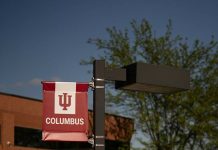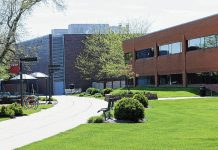Columbus could ask the Louisville & Indiana Railroad to relocate its tracks further west as a proposed solution to alleviate motorist traffic congestion when more than twice as many trains travel through the city beginning in 2018.
Indianapolis-based engineering firm American Structurepoint has presented five alternatives as potential solutions to offset the impact of the railroad’s decision to lease its tracks through Columbus to CSX, which plans to have more trains, as well as heavier ones, cross the city.
Targeted areas include the crossing on State Road 46 and State Road 11 on the western edge of downtown Columbus, estimated to be the worst crossing on the 154-crossing railroad line between Louisville and Indianapolis. That’s as measured by motorist wait times when a train passes, the engineering firm reported Monday to the Columbus Redevelopment Commission.
The railroads are projecting that the city will have 22 longer trains a day passing through Columbus beginning in 2018, compared to eight trains now. The delay until 2018 provides time for the railroads to replace the Flat Rock River Bridge near Columbus, a century-old structure that needs to be widened and altered to carry double-stacked rail cars that CSX plans to use.
[sc:text-divider text-divider-title=”Story continues below gallery” ]
In addition to that change, the trains’ length will be increased, from 5,100 feet now to 7,500 feet.
The consultants reviewed traffic counts at six railroad crossings in Columbus for its study: 11th Street, Eighth Street, Fifth Street, State Road 46, Spear Street and County Road 200S.
The northbound trains, which will be traveling faster and be heavier than the current trains on the line, are expected to increase the wait time at the State Road 46 crossing. It’s currently about 13 minutes for eastbound traffic, but the delay is forecast to increase to about 20 minutes in 2018, and extend to 40-minute delays by 2036.
Those times reflect what will happen if the city does nothing to change the rail crossing configuration, which is one of the five options available to the city, the engineers said.
Two of the options involve moving the railroad tracks about 1,000 to 1,500 feet west of the current crossing, further away from the stoplight at State Road 46 and State Road 11. One option includes an alternative to add a State Road 46 overpass over the railroad tracks, while the other doesn’t.
Ryan Huebschman, American Structurepoint transportation manager, explained moving the crossing further west on State Road 46 would eliminate the crossings in downtown Columbus, and the trains could move faster if they are located away from the city’s urban area, meaning they would clear the west-side crossing faster.
Another option would leave the tracks where they are now and build the State Road 46 overpass only for eastbound traffic, with westbound traffic still having to wait for trains at a grade-level crossing. Huebschman said that option doesn’t benefit the city quite as much but would still move eastbound traffic on State Road 46 more quickly.
Still another option is building an interchange at the east side of the intersection of State Road 46 and State Road 11, replacing the current intersection, and including a bridge for eastbound and westbound State Road 46 lanes to travel over the train tracks.
The city is paying American Structurepoint up to $125,000 to determine impact of the increased train traffic on motorists and the cost and impact of solutions. No construction costs were provided on the options presented Monday.
John Dorenbusch, a redevelopment commission member who leads the committee looking into the railroad impact on Columbus, said representatives for the city have had conversations with Louisville & Indiana and CSX about moving the tracks further west, which are required in two of the five options.
Dorenbusch said he thought the options were all viable, but viability will come down to funding. Moving the railroad tracks will also require discussions with the Indiana Department of Transportation and the Indiana Department of Natural Resources, he said.
Frank Jerome, a city councilman who serves on the redevelopment commission, said he thought the proposals need to be evaluated carefully.
“This is not for one year. It’s forever,” Jerome said. “We have to have a long-range view.”
[sc:pullout-title pullout-title=”What’s next” ][sc:pullout-text-begin]
Indianapolis engineering firm American Structurepoint Inc. said discussing potential rail-line realignment with CSX and seeking project funding are among the next steps in the process. The firm could come back to the Columbus Redevelopment Commission sometime in January or February for another update.
[sc:pullout-text-end]




